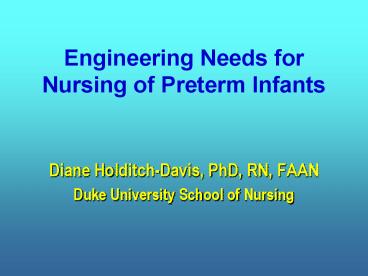Engineering Needs for Nursing of Preterm Infants - PowerPoint PPT Presentation
1 / 39
Title: Engineering Needs for Nursing of Preterm Infants
1
Engineering Needs for Nursing of Preterm Infants
- Diane Holditch-Davis, PhD, RN, FAAN
- Duke University School of Nursing
2
Who are Preterm Infants?
- Born 4 to 17 weeks early
- 70 4-6 weeks early
- Weight 350-4500 gm
- 12.8 of births
- 500,000 annually
- Costs 4 times a healthy fullterm--26 billion
annually
3
Medical Complications of Preterms
- Immunological
- Infections
- Respiratory
- Respiratory distress syndrome
- Chronic lung disease
- Apnea
- Gastrointestinal
- Feeding problems, poor growth
- Necrotizing enterocolitis
- Neurological, including visual and auditory
4
Neurological Complications of Prematurity
- Developmental delay/learning disabilities
- Mental retardation
- Cerebral palsy
- Attention problems
- Visual problems
- Hearing problems
5
Sources of Developmental Risk
- Intrauterine environment
- Neurological insults
- Chronic lung disease
- Intraventricular hemorrhage
- Periventricular leukomalacia
- Seizures
- Sepsis
- NICU environment
- Individual vulnerability
6
Influences on CNS Maturation
Medical Problems
NICU Environment
Genetics
7
Processes of Neurodevelopment
- Induction
- Proliferation
- Migration
- Organizationthird trimester and neonatal periods
8
Organizational Processes
- Alignment and layering
- Elaboration
- Establishment of connections (including
programmed cell death) - Glial proliferation
- Myelination
9
Elaborationa. 25 weeksb. 32 weeksc. term
10
Elimination of Excess Connections
11
Development of the Brain
12
Goals of Nursing Preterm Infants
- Promote survival
- Minimize complications
- Promote normal development
13
Focus on Three Nursing Issues
- Environmental protection
- Assessment of brain functioning
- Feeding
14
Environmental Stimulation
- Lighting
- Noise
- Handling
- Positioning
- Painful Procedures
15
Sequential Onset of Sensory Functioning
Tactile
Vestibular
Chemical
Auditory
Visual
16
Womb
- Rhythmic low level sound
- Dark
- Warm37.5o
- Vestibular stimuli
- Much circadian patterning
17
The NICU
- Loud
- Bright
- Cold
- Painful/unpleasant tactile stimuli
- Minimal circadian patterning
18
Circadian Rhythm Effects
- Physical growth
- Heart rate and temperature regulation
- Sleep-wake state development
- Gastrointestinal enzymes
- Hormone secretion
19
Nursery Re-Design
20
Ongoing NICU Design Issues
- Space
- Noise and light dampening
- Storage
- Alarms
- Infection control
21
Incubator
- Warmth and humidity
- Barrier to infection
- Bed space
22
Issues with Incubators
- Limited visibility
- Difficult access
- Excess light
- Exposure to noise
- from air flow, motor,
- environment
- Water reservoir as source of infection
23
(No Transcript)
24
Warmers as alternatives
- Good visibility
- Easy access
- Open to environment
- Excess light
- Excess noise
- No barrier to infection
- Convective heat loss to air currents
25
Assessment of Brain Functioning
- Instrumented
- Electroencephalography (EEG)
- Ultrasound and imaging
- Near infrared spectroscopy (NIRS)
- Infant behaviors
- Infant sleep
26
Issues with EEG, Ultrasound, and Imaging
- Somewhat invasive
- CT scan and MRI
- Structure, not function
- Require taking baby from NICU
- Require restraint or sedative
- Can not be done during care
27
Issues with NIRS
- Non-invasive measure of cerebral oxygenation
- Can be used during NICU care
- Need for sensors for small heads
- Some versions only give trends
28
Infant Behaviors
- Only way infant can express symptom distress or
response to care - Traditionally assessed by nurses during care
- Limited validation
- Affected by visibility
- Time intensive
- Needs instrumentation
29
Infant Sleep
- Sleep is both consequence and cause
- Changes in sleep may reflect alterations in the
brain
30
Active Sleep
- Quiet Sleep
31
(No Transcript)
32
(No Transcript)
33
(No Transcript)
34
(No Transcript)
35
(No Transcript)
36
(No Transcript)
37
Feeding
- Late developing skill
- Suck/swallow
- 28 weeks--mouthing only
- 33-36 weeks--immature
- Stomach
- 20 weeks--gastric motility and secretion
- Enzymes
- 10 weeks--lactase
- 26 weeks--enterokinase
38
Feeding Progression
- Intravenous feedings
- Hyperalimentation
- Tube feeding
- Continuous by pump
- Gravity
- Bottle- and breast-feeding
39
Issues with Tube Feedings
- Time to hold for gravity drainage
- Difficulty assessing placement in stomach
- Continuous tube feeding require very slow rates
- Feeding pumps not designed to give
- IV push pumps usually used,
- Not designed for viscous fluid
- Unknown pressure































